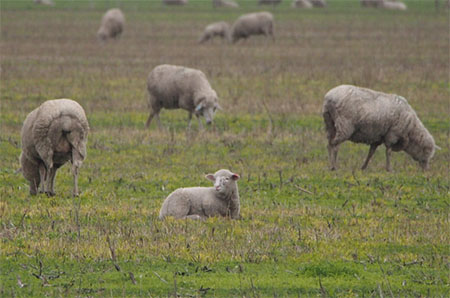By Brendan Voss, Elders Livestock Production Advisor
For many of us, weaning lambs is a stressful time for not only the lambs involved, but the producer too! This doesn’t need to be the case, and if managed
correctly with a little bit of background work, weaning can be a smooth process that not only conserves limited feed supply, but also enables the lambs
to maintain high growth rates. With the current outlook for spring being below average for rainfall, now more than ever is a great time to consider
management practices, like early weaning, that can lower your DSE loading.
It’s not all about the lambs however, as the benefit for the ewes is just as, if not more, significant. Once lambs are weaned, the ewe’s nutritional requirements are drastically lower, improving their ability to return back to desirable condition ready for joining which can directly affect next year’s lambing percentage and ultimately next year’s profitability. Early weaning of lambs also allows for opportunities to sell cull ewes earlier, which in a tighter feed year reduces grazing pressure, and also opens the door to sell cull ewes earlier – given the current mutton pricing, this could be a great decision financially too!
In my experience working with clients, yard weaning lambs over a period of 4-7 days within a small yard or feedlot pen has worked with outstanding results. Lambs upon exit are less stressed and are not as flighty as lambs weaned straight from mum. Managing the stress period over weaning is the key to success. Stress is the main driver of weight loss, and stress can lower the immune system’s ability to fight disease. If done well, lambs don’t have a weaning ‘check’ and continue to grow ahead, again allowing opportunities to sell earlier at a higher weight and price. Another longer term positive for lambs weaned at a younger age is that they have better lifetime efficiency for converting feed into energy, which over a replacement ewe’s lifetime can add up.
A good weaning program begins well before weaning. Feeding grain to the ewes with the lambs at foot teaches the lambs what the grain is and makes the weaning process a lot quicker and less stressful. It takes away the learning phase required when any new feed source is offered to any class of livestock.
Imprint feeding, as it is called, is vital to success and the more imprinting, the better. On weaning day, draft lambs from the ewes, and where possible draft lambs into weight ranges to reduce shy feeding. I would recommend getting lambs straight into the yard setup with grain in a raised trough of minimum 15cm trough space per head. Animal health (i.e. Drench/Vaccinations) should be done on the second or even third day.
If you are interested in knowing more, or discussing your situation, please feel free to contact me, Brendan Voss, Elders Livestock Production Advisor, on 0427 391 470 or attend a Winning with Weaners workshop (see the SheepConnect SA Events page for details on upcoming workshops)





